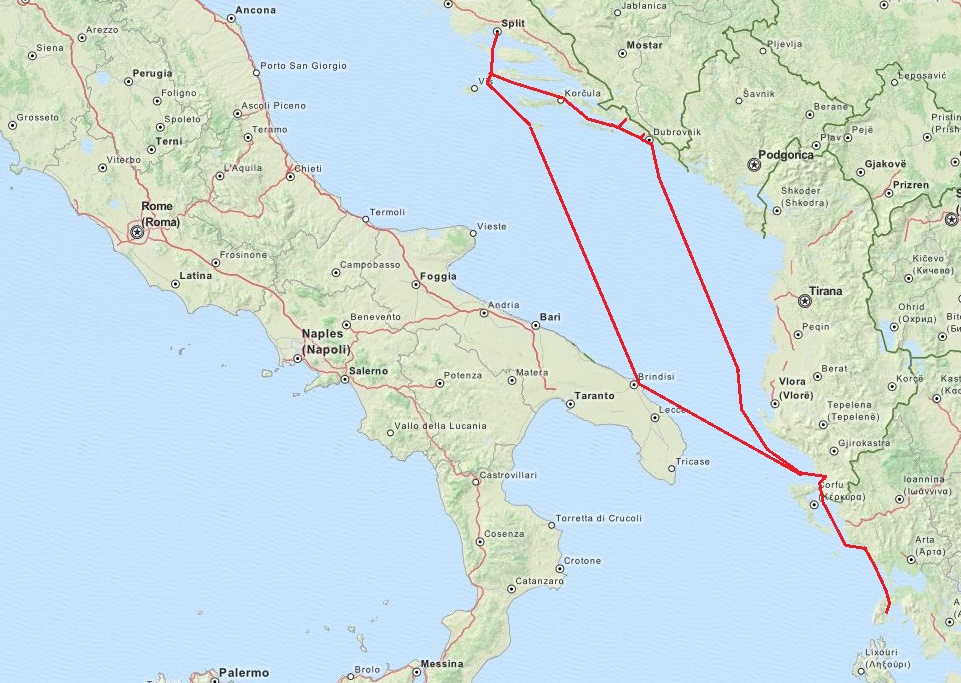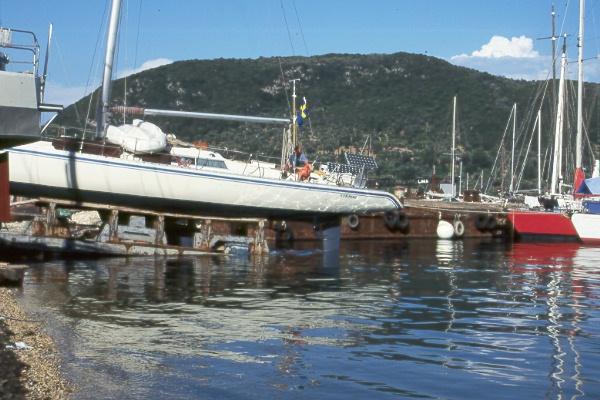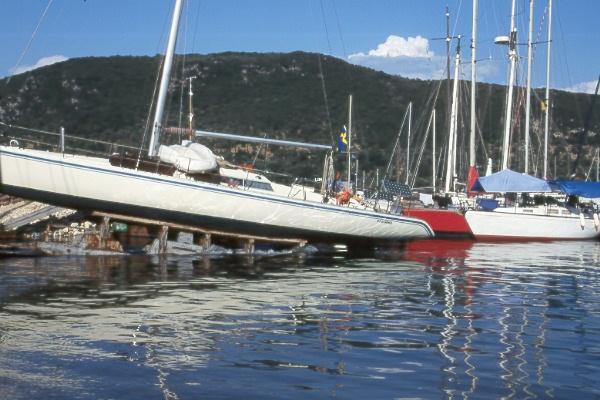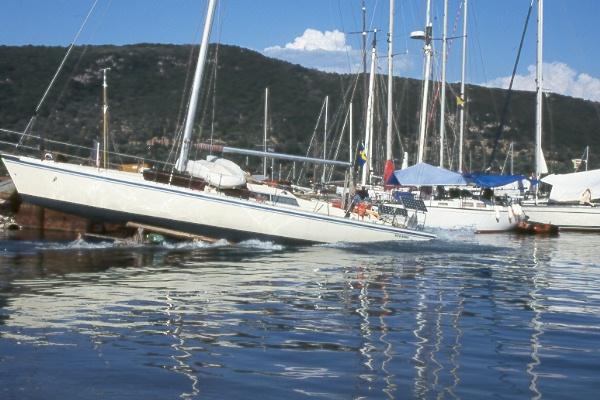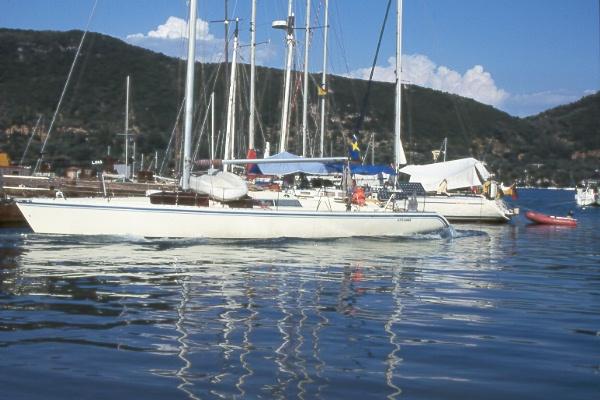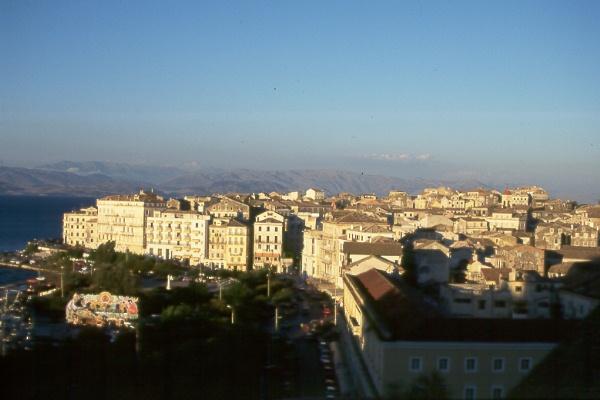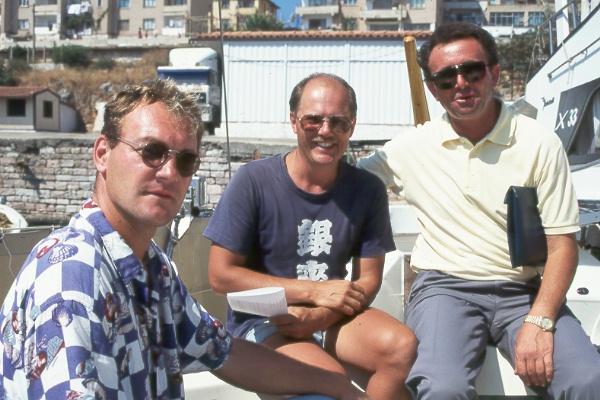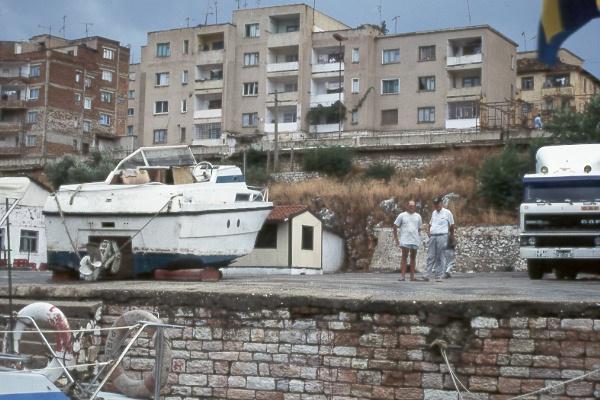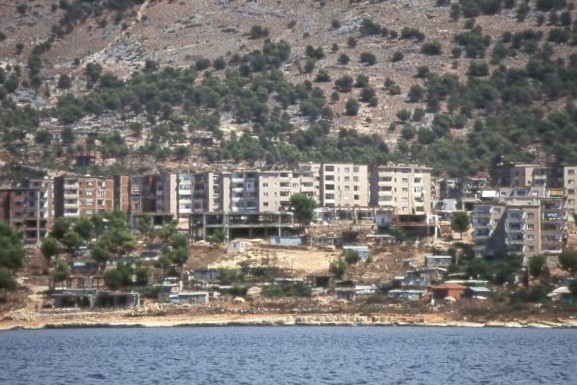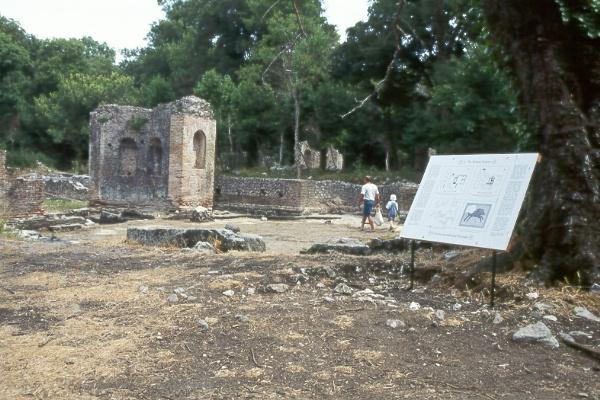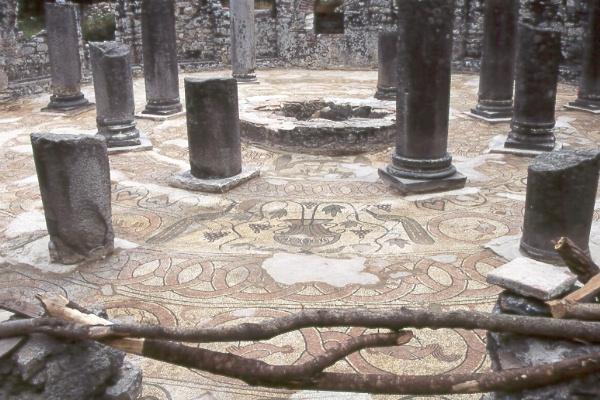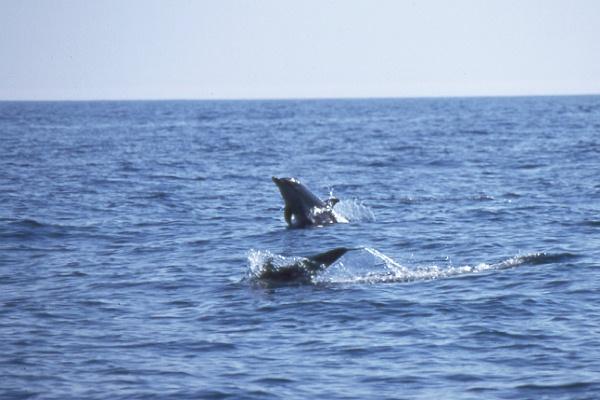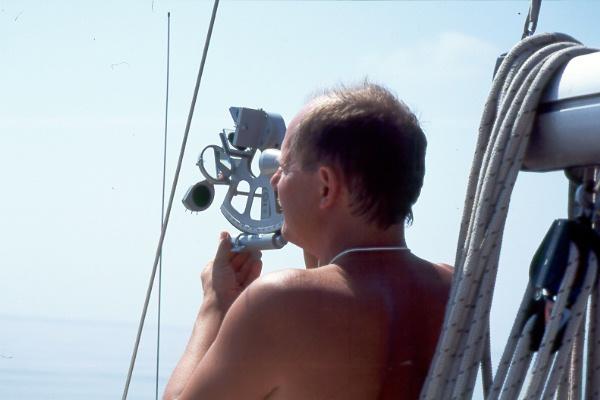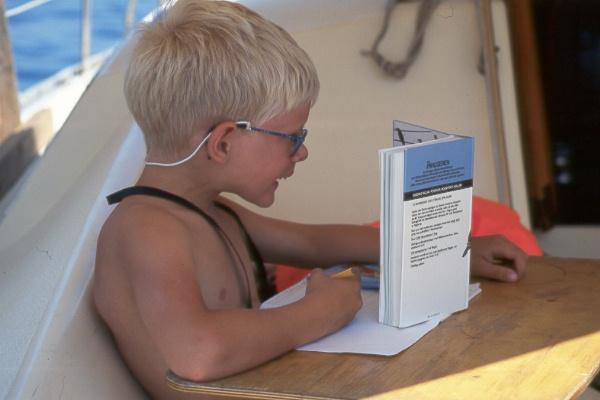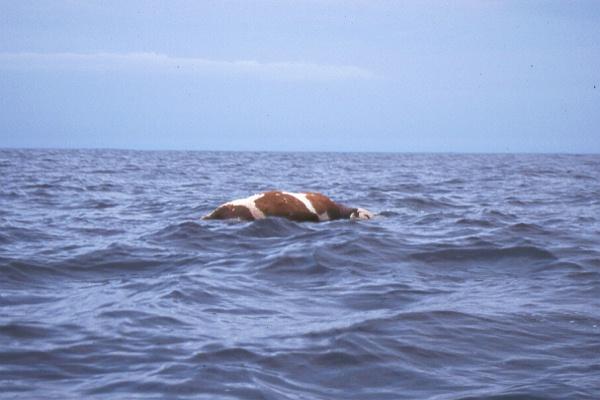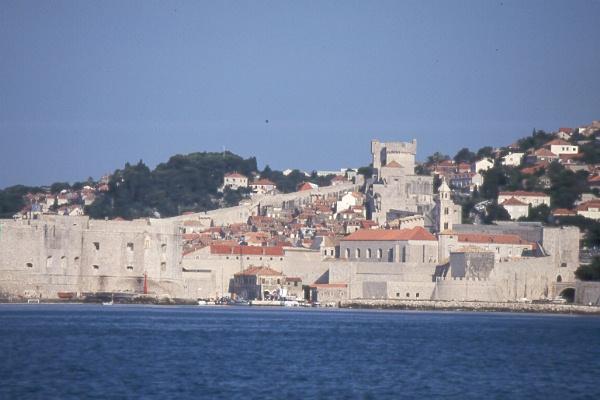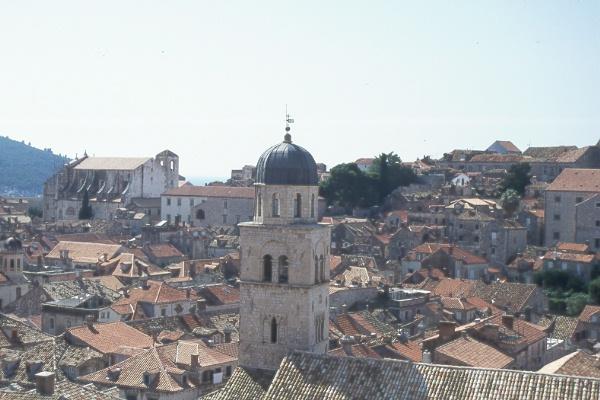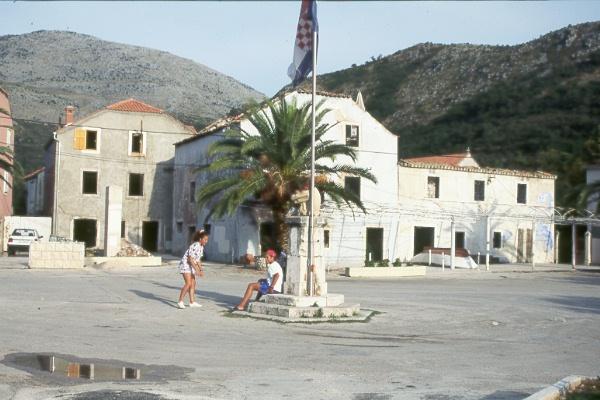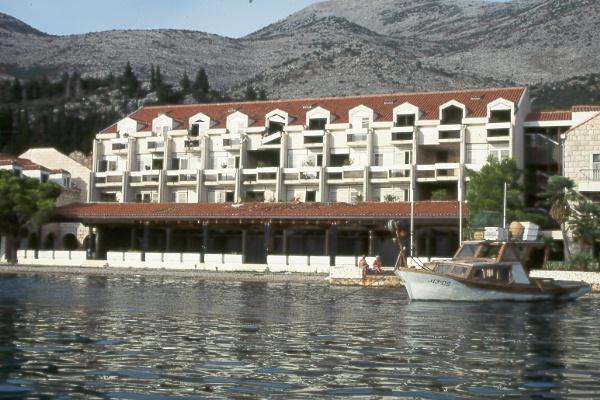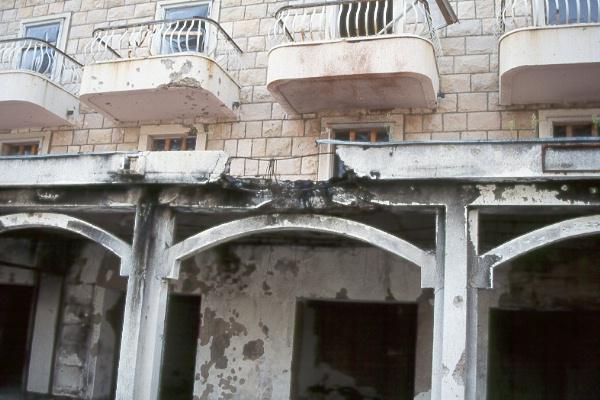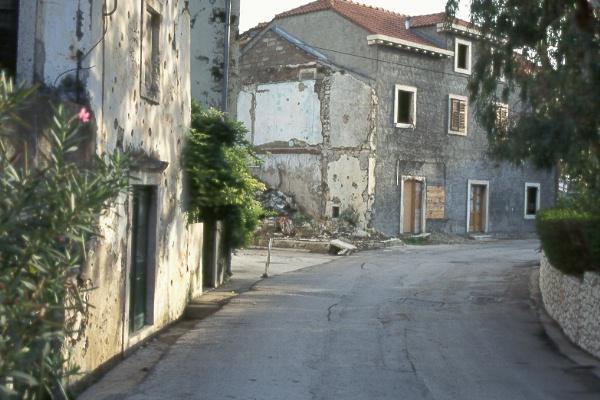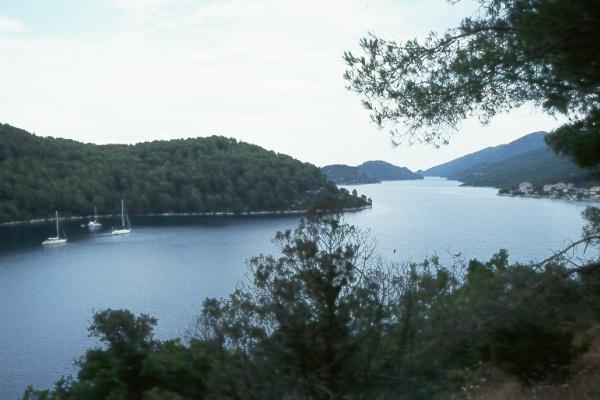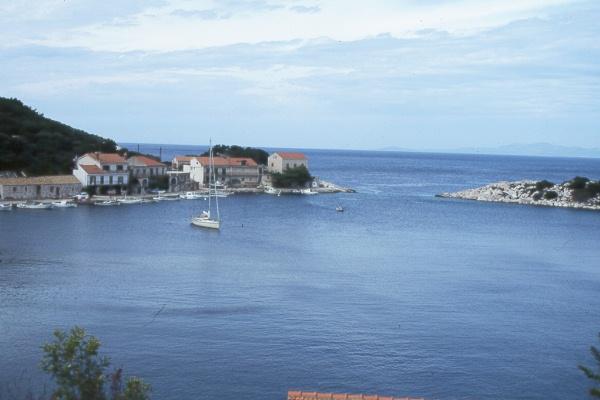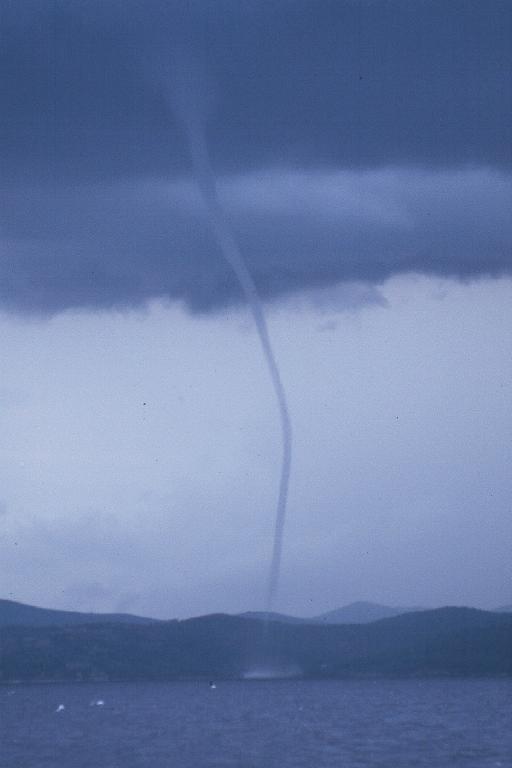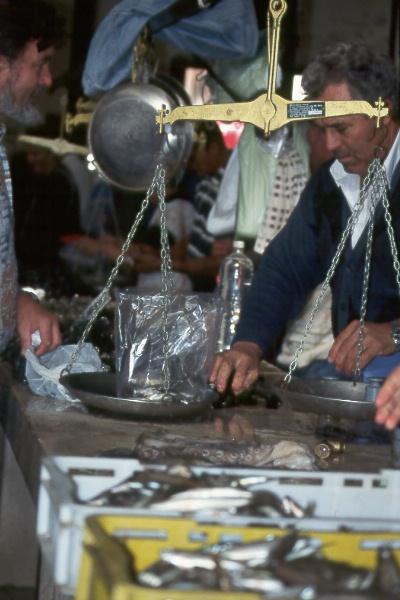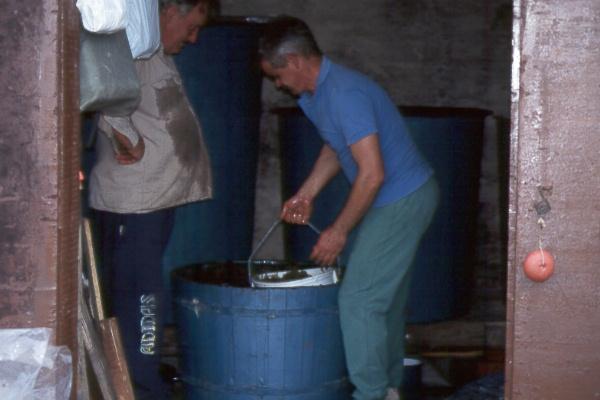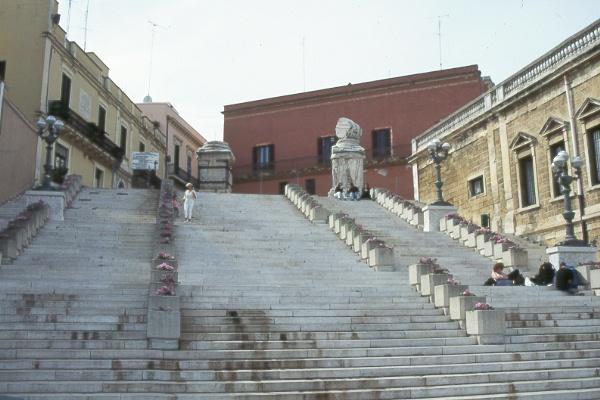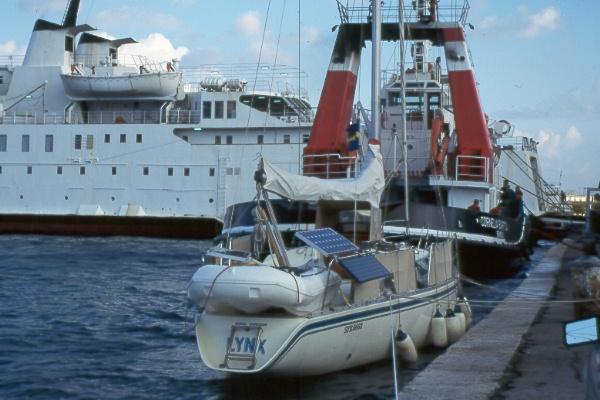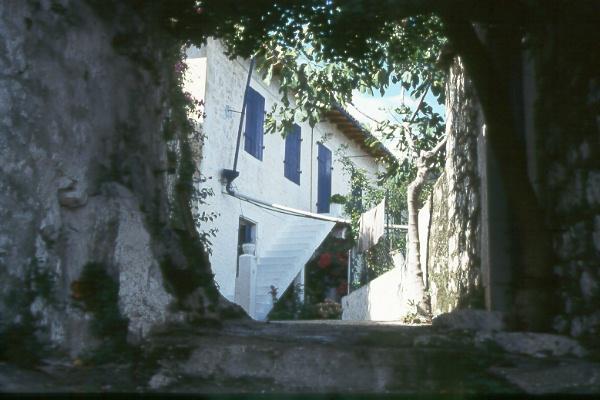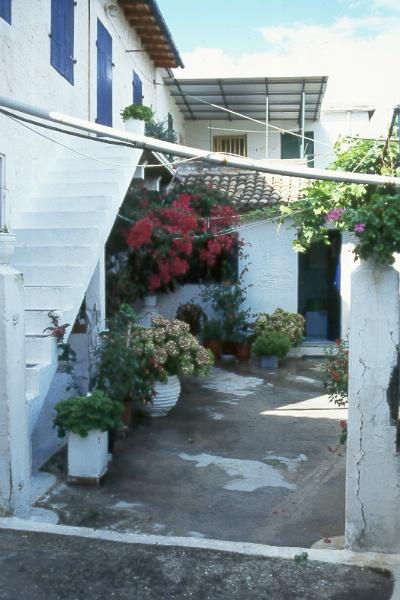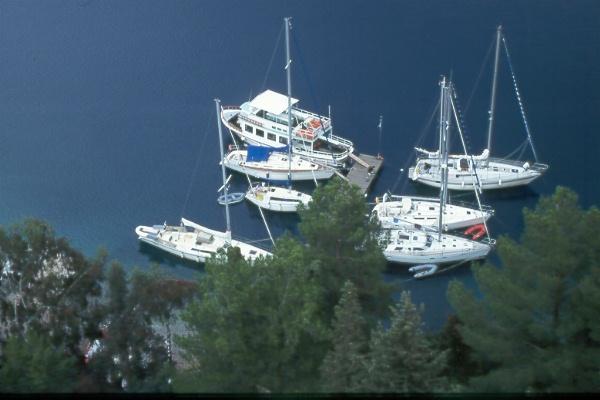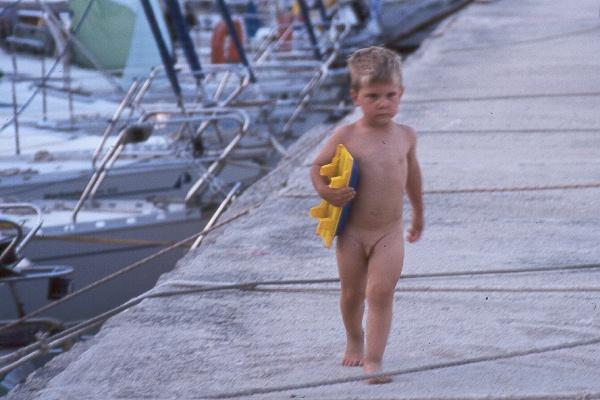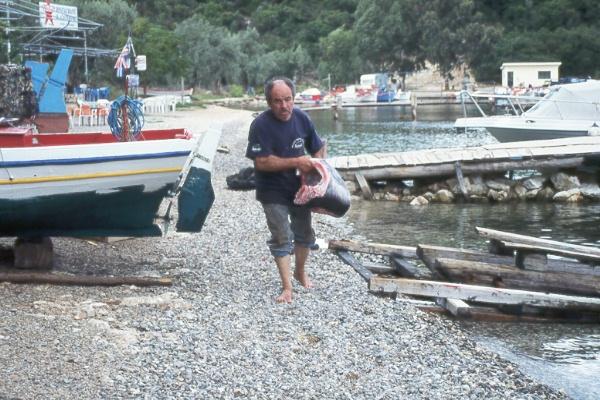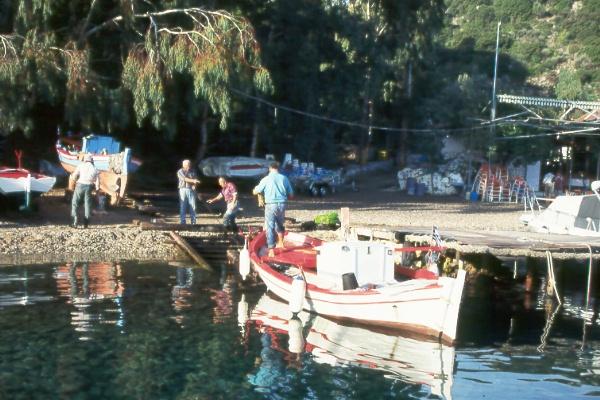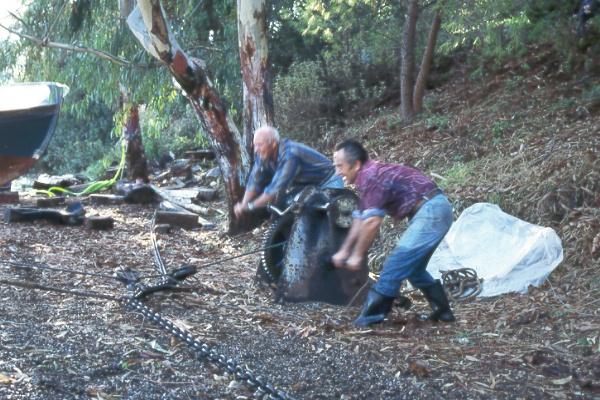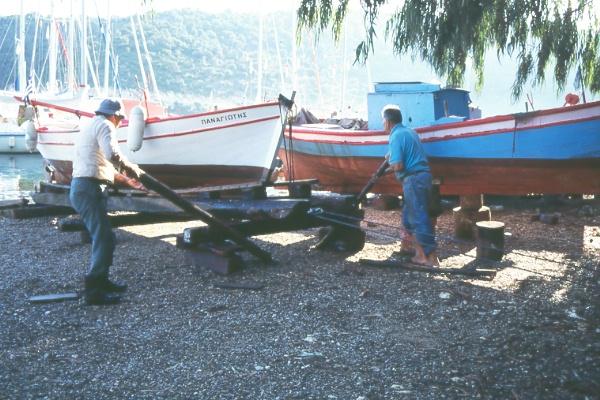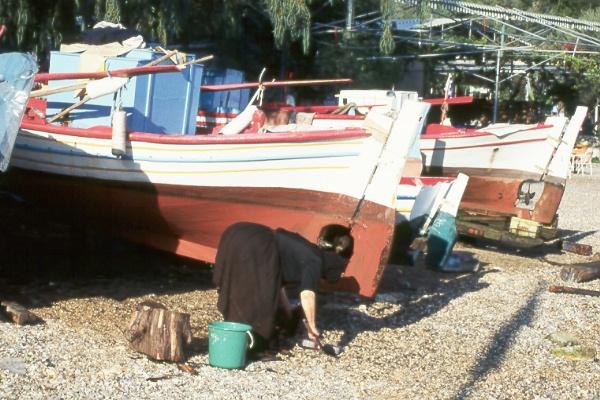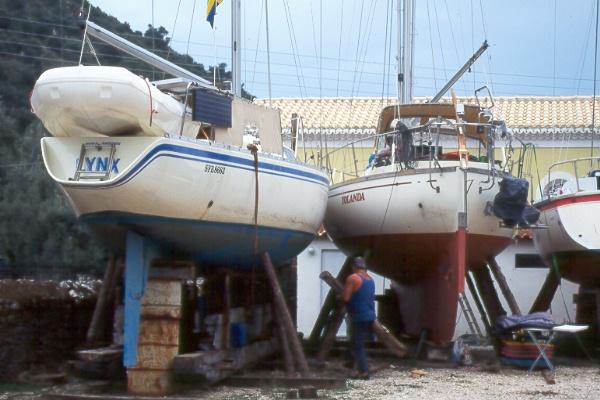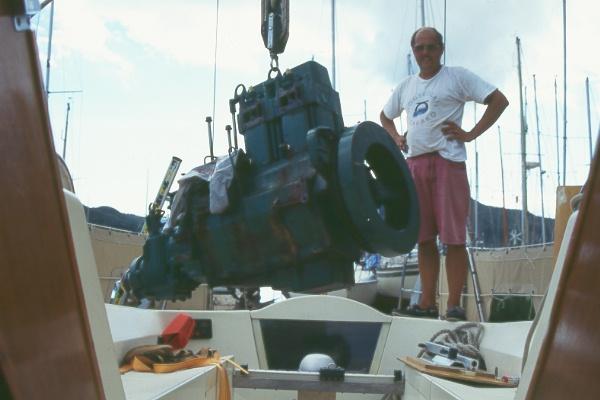
 1996
1996


The Adriatic Sea
Greece, Albania, Croatia and Italy by Johan Kjellander 1996-2014 På svenska
Summer-96 we took our van down to Greece and launched Lynx first week in August. We then sailed north, stayed a few days in Albania and continued to Croatia which was a war zone only a year earlier. Before the war there were many Swedish boats in the Croatian Archipelago but now it was almost empty.
In october we turned south again and spent some weeks in Greece before we took our van back to Sweden again, where we we arrived early in November. This year we sailed 800 NM.
Tove took the pictures and I wrote the texts.
Greece
Launching is always nervous. This time it didn't go at all at first, but then it went faster!
It started as usual with the men putting their old wooden sleigh under the boat and lifted it from the ground. Ten they tried to pull the boat back down towards the water but it did not want to move. They pulled with their tractor and they pushed and worked in the heat. Finally she moved a little. Maybe they were afraid that she would get stuck again so for safety, they put on a new layer of wax on all the sleepers. Once down by the water, they stopped the winch and I had to step up and take care of the tiller. They especially said that I should hold tight and aim straight back.
Then they released the wire that held the boat and we started sliding backwards. Faster and faster. Very fast!
With a huge splash we met the water and a large wave came over the aft deck right into the cockpit. Fortunately, all went well but for a short moment the panic was close. Even the old men on land were nervous. I saw that they looked worriedly at the boat to see how I managed to hold the tiller. It wasn't meant to go that fast.
Well, after a long winter at home in Sweden, it is always nice to come out to sea again, the faster the better!
We wanted to sail up north into the Adriatic. First we wanted to stop in Albania and then see the former Yugoslav archipelago, now belonging to Croatia. Many sailors who come to Greece continue east to Turkey but we didn't want to miss Croatia.
From Lefkas it's a two day trip north to Corfu, the green island. Corfu is a wonderful old town with narrow alleys and lots of shops. If you want, you can stay for free in the old harbor crowded with tourist boats. Then it's close to the center. If you want to be in a marina, there is one not far away.
The picture is taken from the top of the castle down over the old town eastwards towards Albania, which was our next destination.
Albania
From Corfu, you can almost see over to Saranda, a small poor harbor town in southern Albania. We had tried to find out if we could go there, but it was difficult to get reliable information. The pilot book stated that it was possible but that it could be very difficult. It even warned for minefields just off the coast.
When we asked a man in a boat shop in Corfu, he was completely puzzeled. Why should we sail to Albania? The fact is that the Greeks have a lot of problems with criminal gangs who illegally come over to Corfu and do bad things. The Albanians are incredibly poor and the country is more or less in a state of anarchy. It was even claimed that an English sailor had been murdered on his boat inside the marina just a few days before we arrived. He had woke up in the middle of the night and discovered thieves trying to steal his dinghy. He then pulled a revolver and fired a shot in the air and as a result was killed by fire from an automatic weapon. Of course, how much is true, we do not know, but it is not in the Greek authorities' interest to scare the tourists with such stories so one can assume that it was not in the newspapers the next day.
It was with some doubt that we steered the course towards Saranda. However, it would turn out that our fears were exaggerated. A short distance from the harbor entrance we were called on the radio and a voice in excellent English explained how to find our way in to the harbour and where we would find a berth. On the quay were two friendly Albanians waiting.
One of them presented himself as an agent for the authorities and the other ran a tourist agency. The agent fixed all papers in less than 15 minutes and we paid in dollars. It turned out that we had ended up right in the centre of the military marina. Beside us, two civilian Albanian boats were lying and on land were a few more. Otherwise it was just worn out military and rusty patrol boats. We were the 4th foreign sailboat that year!
The tourist guy turned out to be married to a Dutch woman and together they had moved into the governor's palace and there they ran a guesthouse and tourist office. They tried hard to attract foreigners to come and they offered us to go on a donkey safari in the mountains or visit the inaccessible ruin area Butrint a few miles away. We deinitely wanted to see Butrint.
Slowly, we began to realize how poor people were and how insecure the situation was. The houses were becoming ruins, the streets in bad shape and in the sidewalks there were big holes where the street lights had stood. People had dug them up and sold the metal for money.
The tourist guy was Ani and he invited us to come in the evening for a cup of coffee in the old Governor's Palace. Of course, we accepted such hospitality. He didn't think there would be any problems leaving the boat unattended in the harbor if we weren't too long. Ani and wife Wilma told us during the evening how it was to live in Albania and we hardly believed our ears. Orphaned children, crime and poverty and much more. They themselves belonged to the upper class, who could even legally go to Corfu for shopping every now and then.
A few hours later we were back in the boat and everything was well. We put the kids to bed and sat down in the cockpit to relax with a glass of wine. Suddenly, a young soldier comes down and asks for help desperately. He was completely broken with big wounds on his face, arms and feet. He could hardly find any English words so we did not initially understand what had happened and were of course worried also for our own safety. Was he on the run and wanted to hide or what did he want? After a while we understood. He and some friends had been out on the pier among the big boulders for fishing. He had fallen unluckily among the sharp rocks and simply needed help with his wounds. Then he came to us. I still wonder why. There should be some kind of healthcare even in Albania? He probably didn't have the money for it or it didn't exist. We did the best we could, washed the wounds and put dressings on them. He was very grateful and after an hour or so his friends helped him to the barracks.
The next day we had a meeting with Ani to plan for an excursion to the ruins of Butrint. He fixed a car with a driver and offered to arrange a guard who would sit in the cockpit of the boat while we were away. A full day by car was $ 20 and the guard another 5.
Butrint is a 2000-year-old Illyrian (Roman) city ruin which in many respects is as well preserved and amazing as the Acropolis in Athens but not as well known. It takes some hours to get there on incredibly bad roads and once there you are completely alone. Not a single tourist except us! We went around for a long time and watched and the children fantasized about how the people lived 2000 years ago.
In spite of the decay, some work was luckily under way. They had put up signs in English and also excavated this beautiful mosaic. A foundation had been set up to receive foreign donations to preserve the area for the future.
Imagine that a country can sit on such a cultural treasure but be completely incapable of exploiting it for the benefit of their people. Here, 1000's of tourists should come every day and spend their money but now it's completely empty.
Croatia
After a few days in Saranda it was nice to continue up north. We left the poor Albanians and sailed towards Dubrovnik in former Yugoslavia. About 200 nautical miles and very weak winds. Most of the way we had to use our engine.
There are a lot of dolphins in the Mediterranean and it is just as fun every time they come and visit.
Without wind it soon gets boring. I got a sextant when I turned 40 and now I took it out to refresh my memory. That was not easy. Pretty soon I realized that I didn't even have the right tables with me. Well, one noon sight is easy and then I figured out the declination with an approximate formula that I found in a book and after a long time I managed to find that we were about 10 miles south!
Until next year, at least I now knew which tables I needed!
The kids also must have something to do. Here it is Martin playing birdwatcher. Binoculars around the neck and bird book in front of him. For several days he amused himself by writing the names of different birds. If you are not at home and go to school, you can train on the boat instead.
Suddenly, there is something floating in the water. We adjusted the course to get closer and realized that it was actually a dead cow in front of us. Imagine how it smelled. No land in sight as far as the eye reaches, I wonder where it came from?
On the second day in the evening we arrived to Dubrovnik. The old medieval port city that now belongs to Croatia but which before the war was part of Yugoslavia. When the Croatians decided to leave Yugoslavia, the Yugoslav navy came and shot artillery from the sea towards the city. 250 grenades buried within an area no greater than a few hundred meters in square. It is as if Gotland would suddenly explain themselfs independent and the Swedish navy would go there and shoot Visby into pieces.
Large international rescue operations have been carried out to collect money for repairs and when we got there most of it was taken care of. Streets and houses were still scarred by shrapnel but most rooftops had new bricks. Churches and museums were open and tourists had begun to return. We anchored outside the old harbour and continued the next day to Dubrovnik's commercial port of Gruz, just next door.
In Gruz we cleared and got our sailing permit. It costed 2,000:- (200 USD) and the harbor fee was about 100:- per day. For that we had no shower, no electricity and no water. We began to realize that it was expensive in Croatia and worse it would be.
We stayed a few days in Dubrovnik and enjoyed the beautiful old city and its surroundings. The picture above is taken up from the ring wall down over the newly repaired rooftops in the old city center.
12 miles north of Dubrovnik lies the small village of Slano well protected in a small bay. We thought it looked nice and decided to anchor in the bay overnight. The next morning we took the dinghy ashore and then we realized that it was more or less a ghost town we came to.
In the town square, the statue was gone but a provisionally tied Croatian flag had taken its place. A few lonely children played among the ruins. Virtually all houses within sight from the beach were more or less destroyed. Further inland, the houses had done better.
The facade of the house to the left belongs to a former hotel. Now bombarded and abandoned. On the picture to the right you can clearly see how a grenade has hit.
Empty, abandonned and wounded. On the house wall to the left you see traces of bullets and shrapnels. How can people do this to each other? People who even lived as neighbours in the same country throughout their lives.
We left the sad signs of war and sailed out into the beautiful archipelago. One of the first islands is called Mljet. In the bay below we anchor along with an American boat which we incidentally met again a year later in Spain! We took the bikes ashore and made excursions. Among other things, to a small lake which in turn has an island where there is a monastery. That night we had a spectacular thunderstorm over us. Lightnings hit the mountains around us so often is was almost like daylight. Some really close, you could se the impact on the ground with soil and dust splattering around.
The next day the weather was fine again and I took the opportunity to snorkel a couple of hours. The result was a cardigan, a snorkel, a little cutlery and a crab shell. If you snorkel in popular anchorages you often find lost things. Most of our towels on board are finds from the bottom. A flawless red Lacoste sweater, a pair of good swimwear, some nice glasses, a dorado ventilator and various bathing suits also belong to the collection.
This image comes from the small island of Lastovo. Far out in the sea and more unprotected than the other islands. Yet there are several nice bays to anchor in. Before the war, this was a naval base and it was not possible to come here with a sailboat. Now it was allowed and it was noticed that the people on the island were not used to visits by sailors. They were very friendly and when we took a walk up the mountains to look at the little village up there we were of course picked up by cars in both directions. Paying was not a issue.
The water around the island was very clear and nice and we heard from other sailors that there were many interesting places to dive around Lastovo.
We continued nourth through the archipelago. The weather became unsteady and suddenly we saw a strange phenomenon in the sky. A long, pulsating hose that stretched from the surface of the water up to a very black cloud. Just a few hundred meters from the boat. It was a tornado. Whoops, you don't want to get close to that one. A tornado is like a vacuum cleaner, down at the water surface the air blows with incredible strength towards the center of the tornado. The air brings water up into the hose and as close as we were we clearly saw how the water was transported up to the cloud in spiral form.
We furled in our jib, started the engine and drove away as quickly as we could. After a few minutes the tornado was gone.
We continued slowly north through the archipelago and visited islands like Korcula, Brac and Hvar before we arrived to the big city of Split. Split did well during the war and here we saw no traces of fighting. We found a small marina on the inside of the peninsula on which the town is situated and it turned out to be a very nice place. Both we and the children got many new acquaintances during the days we were there. German, Danish, Dutch and Swiss. We had fun and it all ended with a big party on the quay with barbeque and masquerade for all children.
Before the war, Split was a great sailing mecka with both domestic charter boats and lots of foreign boats visiting. Not least Swedish. During the war many boats were forced away and now it was considerably thinner. Here, too, we noticed that they appreciated a foreign boat. Of course, they miss the time before the war and want everything to be as it once was.
Tove has taken this picture in the big fish market in central Split. There we bought swordfish and other delights. In the middle of the city is also the Roman emperor Diocletian's palace. What's left are ruins under the current street level and they are well restored to a museum. One of the larger halls is used during the summer for concerts and opera performances.
Split became the turning point for our trip this summer. Unfortunately, we had not time enough to continue further north where there is more to see. However, we thought we had seen enough and started longing for Greece so we left Split and sailed south. The last stop in Croatia became the island of Lastovo, where we were invited to see traditional wine making. The grapes are grown on the slopes, picked in September and run home on barren small mountain roads. The preparation itself is done with very old-fashioned methods.
From Lastovo, we turned back to Greece, but the weather had other plans for us.
Italy
We left Lastovo and aimed for Greece but on the second day in the afternoon we got sea and wind straight against us. Flexible as we are, we quickly changed our plans and decide to sail to Italy instead! The nearest sensible port was Brindisi and there we arrived in the middle of the night, very tired.
Brindisi is a large port with a constant traffic of passenger ferries going to various ports in Greece and Turkey. Much of the car traffic from northern Europe that previously went south through Yugoslavia is now passing through Italy instead by ferry via Brindisi.
In Brindisi you also find the famous staircase in the picture above. The pillars at the top mark the beginning of the ancient paved highway Via Appia which united Eastern and Western Italy. Via Appia continues all the way to Rome where large parts are still preserved.
It was nice to come to Italy after seeing the misery in Albania and Croatia. No paper exercise thanks to the EU and no harbor fee either. We stayed in the center of the city among ferries and tugs several days and waited for better weather.
Now, with some distance to war and misery, you realize how amazingly well off we are in Sweden. Coming to Italy felt like being home.
Greece
Autumn approached, it was the beginning of October and the weather became increasingly unstable. In the end, however, the wind turned and the forecast on our NAVTEX promised good winds over the next few days. We left at 9 o'clock in the morning from Brindisi, first in a weak southerly wind but then in constantly stronger wind until we sailed with just a small piece of the jib. The sea gets rough right here in between the Adriatic and the Ionian sea so we had a difficult journey. After 12 hours, we arrived in the calm bay on Erikusa's south side. Erikusa is one of the northernmost Greek islands with a kilometer-long sandy beach that was completely deserted. A real paradise. In 12 hours we had sailed 90 miles.
Now we would relax from war, misery and strong winds and just have a nice time. We continued south past Corfu and down to our home waters around Lefkas. There we spent the last few weeks in warm and nice weather together with the Swedish boat Yolanda.
Just east of Lefkas is an island called Meganisi. The northern side is shattered by deep protected bays and there is much to experience. In one of the bays, lies the small village of Spartokouri high up on a cliff. A small, very traditional village with narrow passageways and strong colors.
In the middle of October, it is still warm and nice and vegetation thrives.
From the top of the cliff where the village is located, you have a nice view of the small harbor. The jetty in the picture belongs to a small restaurant which is situated down by the sandy beach and if you have dinner there you are free to use the jetty.
Here is Gustav the harbour master, 3 years old inspecting the boats. He has his own boat with him under his arm.
The restaurant down by the water is run by a large and nice family of three generations. Here is the grandfather who comes with a piece of a swordfish that is to be cut and prepared for the evening. He puts it in the sea, cuts it apart with a large knife and rubs the pieces with stones. Just next door are all boats with their sewers! In the evening we will order swordfish.
While Grandpa prepares the fish, three fishermen come and haul out a boat. The same traditional slip with a sleigh as on our own boatyard but on a smaller scale of course. It was interesting to see how they did it.
Two guys on the winch pulling up the boat from the water. Then it is moved in to the right position and supported with props.
Finally, Grandma comes down with the scrubbing brush. The fishermen then sit on the restaurant drinking cofee.
By the end of October, it was our turn. We and Yolanda once again ended up side by side.
Before we went home, however, we had to do something to our engine. It had stopped totally at one point and I suspected it had overheated. To be sure, I removed one cylinder head and cylinder. It didn't look good. There was only one thing to do and that was to take the engine out for a complete renovation. We decided to take it with us back home to Sweden and fix it during the winter.
Said and done. Loosen all screws and connections. The main sheet around the boom and out with the engine. We parked the bus right below and managed to poke the engine in on the floor between the seats. The kids got less space for their feet but they didn't complain. It was fun to sit on the engine.
Once home, a complete renovation and assembly of a new cooling system took place. It turned out that lime deposits had formed in the cooling channels of the cylinders, which ultimately put a stop to the cooling. The cooling still worked in the cylinder heads and the exhaust liner where the sensor to the temperature gauge is, so we had not seen anything abnormal on the instruments. Only the cylinders were overheated. All 3 pistons totally destroyed!
Next spring we returned with a newly refurbished engine in better condition than ever and sailed on to Spain but that is another story. This is the end of 1996 years sailing!
